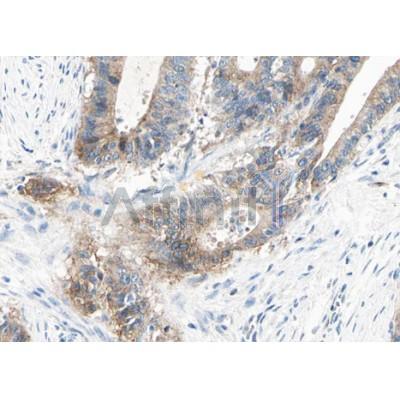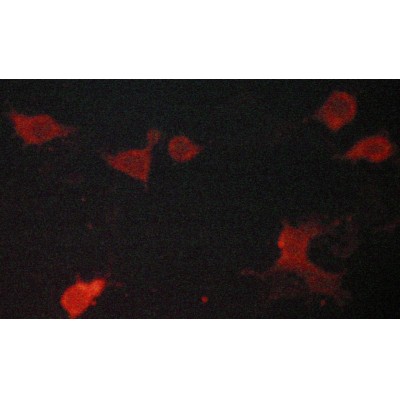Actinin alpha 2/3 Antibody - #AF5248
| Product: | Actinin alpha 2/3 Antibody |
| Catalog: | AF5248 |
| Description: | Rabbit polyclonal antibody to Actinin alpha 2/3 |
| Application: | WB IHC IF/ICC |
| Reactivity: | Human, Mouse, Rat |
| Prediction: | Bovine, Horse, Sheep, Rabbit, Dog, Chicken, Xenopus |
| Mol.Wt.: | 103 kDa; 104kD,103kD(Calculated). |
| Uniprot: | P35609 | Q08043 |
| RRID: | AB_2837734 |
Related Downloads
Protocols
Product Info
*The optimal dilutions should be determined by the end user.
*Tips:
WB: For western blot detection of denatured protein samples. IHC: For immunohistochemical detection of paraffin sections (IHC-p) or frozen sections (IHC-f) of tissue samples. IF/ICC: For immunofluorescence detection of cell samples. ELISA(peptide): For ELISA detection of antigenic peptide.
Cite Format: Affinity Biosciences Cat# AF5248, RRID:AB_2837734.
Fold/Unfold
Actin binding protein; Actinin alpha 2; ACTN 2; ACTN2; ACTN2_HUMAN; Alpha actinin 2; Alpha actinin skeletal muscle; Alpha actinin skeletal muscle isoform 2; Alpha-actinin skeletal muscle isoform 2; Alpha-actinin-2; CMD1AA; F actin cross linking protein; F-actin cross-linking protein; Actinin alpha 3; actinin, alpha; ACTN 3; ACTN3; ACTN3_HUMAN; Alpha actinin skeletal muscle; Alpha actinin skeletal muscle isoform 3; Alpha-Actinin 3; Alpha-actinin skeletal muscle isoform 3; Alpha-actinin-3; F actin cross linking protein; F-actin cross-linking protein; MGC117002; MGC117005; OTTHUMP00000219049; OTTHUMP00000219054;
Immunogens
A synthesized peptide derived from human Actinin alpha 2/3, corresponding to a region within N-terminal amino acids.
Expressed in both skeletal and cardiac muscle.
Q08043 ACTN3_HUMAN:Expressed only in a subset of type 2 skeletal muscle fibers.
- P35609 ACTN2_HUMAN:
- Protein BLAST With
- NCBI/
- ExPASy/
- Uniprot
MNQIEPGVQYNYVYDEDEYMIQEEEWDRDLLLDPAWEKQQRKTFTAWCNSHLRKAGTQIENIEEDFRNGLKLMLLLEVISGERLPKPDRGKMRFHKIANVNKALDYIASKGVKLVSIGAEEIVDGNVKMTLGMIWTIILRFAIQDISVEETSAKEGLLLWCQRKTAPYRNVNIQNFHTSWKDGLGLCALIHRHRPDLIDYSKLNKDDPIGNINLAMEIAEKHLDIPKMLDAEDIVNTPKPDERAIMTYVSCFYHAFAGAEQAETAANRICKVLAVNQENERLMEEYERLASELLEWIRRTIPWLENRTPEKTMQAMQKKLEDFRDYRRKHKPPKVQEKCQLEINFNTLQTKLRISNRPAFMPSEGKMVSDIAGAWQRLEQAEKGYEEWLLNEIRRLERLEHLAEKFRQKASTHETWAYGKEQILLQKDYESASLTEVRALLRKHEAFESDLAAHQDRVEQIAAIAQELNELDYHDAVNVNDRCQKICDQWDRLGTLTQKRREALERMEKLLETIDQLHLEFAKRAAPFNNWMEGAMEDLQDMFIVHSIEEIQSLITAHEQFKATLPEADGERQSIMAIQNEVEKVIQSYNIRISSSNPYSTVTMDELRTKWDKVKQLVPIRDQSLQEELARQHANERLRRQFAAQANAIGPWIQNKMEEIARSSIQITGALEDQMNQLKQYEHNIINYKNNIDKLEGDHQLIQEALVFDNKHTNYTMEHIRVGWELLLTTIARTINEVETQILTRDAKGITQEQMNEFRASFNHFDRRKNGLMDHEDFRACLISMGYDLGEAEFARIMTLVDPNGQGTVTFQSFIDFMTRETADTDTAEQVIASFRILASDKPYILAEELRRELPPDQAQYCIKRMPAYSGPGSVPGALDYAAFSSALYGESDL
- Q08043 ACTN3_HUMAN:
- Protein BLAST With
- NCBI/
- ExPASy/
- Uniprot
MMMVMQPEGLGAGEGRFAGGGGGGEYMEQEEDWDRDLLLDPAWEKQQRKTFTAWCNSHLRKAGTQIENIEEDFRNGLKLMLLLEVISGERLPRPDKGKMRFHKIANVNKALDFIASKGVKLVSIGAEEIVDGNLKMTLGMIWTIILRFAIQDISVEETSAKEGLLLWCQRKTAPYRNVNVQNFHTSWKDGLALCALIHRHRPDLIDYAKLRKDDPIGNLNTAFEVAEKYLDIPKMLDAEDIVNTPKPDEKAIMTYVSCFYHAFAGAEQAETAANRICKVLAVNQENEKLMEEYEKLASELLEWIRRTVPWLENRVGEPSMSAMQRKLEDFRDYRRLHKPPRIQEKCQLEINFNTLQTKLRLSHRPAFMPSEGKLVSDIANAWRGLEQVEKGYEDWLLSEIRRLQRLQHLAEKFRQKASLHEAWTRGKEEMLSQRDYDSALLQEVRALLRRHEAFESDLAAHQDRVEHIAALAQELNELDYHEAASVNSRCQAICDQWDNLGTLTQKRRDALERMEKLLETIDRLQLEFARRAAPFNNWLDGAVEDLQDVWLVHSVEETQSLLTAHDQFKATLPEADRERGAIMGIQGEIQKICQTYGLRPCSTNPYITLSPQDINTKWDMVRKLVPSCDQTLQEELARQQVNERLRRQFAAQANAIGPWIQAKVEEVGRLAAGLAGSLEEQMAGLRQQEQNIINYKTNIDRLEGDHQLLQESLVFDNKHTVYSMEHIRVGWEQLLTSIARTINEVENQVLTRDAKGLSQEQLNEFRASFNHFDRKQNGMMEPDDFRACLISMGYDLGEVEFARIMTMVDPNAAGVVTFQAFIDFMTRETAETDTTEQVVASFKILAGDKNYITPEELRRELPAKQAEYCIRRMVPYKGSGAPAGALDYVAFSSALYGESDL
Predictions
Score>80(red) has high confidence and is suggested to be used for WB detection. *The prediction model is mainly based on the alignment of immunogen sequences, the results are for reference only, not as the basis of quality assurance.
High(score>80) Medium(80>score>50) Low(score<50) No confidence
Research Backgrounds
F-actin cross-linking protein which is thought to anchor actin to a variety of intracellular structures. This is a bundling protein.
Ubiquitinated by FBXL22, leading to proteasomal degradation.
Cytoplasm>Myofibril>Sarcomere>Z line.
Note: Colocalizes with MYOZ1 and FLNC at the Z-lines of skeletal muscle.
Expressed in both skeletal and cardiac muscle.
Belongs to the alpha-actinin family.
F-actin cross-linking protein which is thought to anchor actin to a variety of intracellular structures. This is a bundling protein.
Expressed only in a subset of type 2 skeletal muscle fibers.
Belongs to the alpha-actinin family.
Research Fields
· Human Diseases > Cardiovascular diseases > Arrhythmogenic right ventricular cardiomyopathy (ARVC).
Restrictive clause
Affinity Biosciences tests all products strictly. Citations are provided as a resource for additional applications that have not been validated by Affinity Biosciences. Please choose the appropriate format for each application and consult Materials and Methods sections for additional details about the use of any product in these publications.
For Research Use Only.
Not for use in diagnostic or therapeutic procedures. Not for resale. Not for distribution without written consent. Affinity Biosciences will not be held responsible for patent infringement or other violations that may occur with the use of our products. Affinity Biosciences, Affinity Biosciences Logo and all other trademarks are the property of Affinity Biosciences LTD.








